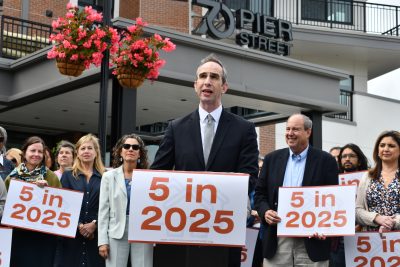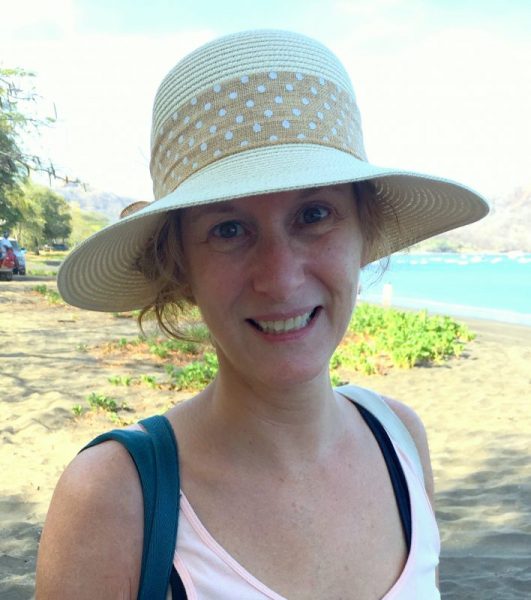Campaign Offers Westchester Road Map to Navigate Housing Crisis
News Based on facts, either observed and verified directly by the reporter, or reported and verified from knowledgeable sources.

Tackling the housing shortage in Westchester has long been an uphill battle for Westchester communities. The Welcome Home Westchester Campaign, which launched three years ago, addresses the overwhelming need for more housing and affordable homes on Monday at a construction site near the Ludlow Metro-North train station.
The site, at 70 Pier St. in Yonkers, is being developed with three multifamily buildings.
Timothy Foley, CEO of the Building Realty Institute (BRI) and a member of Welcome Home Westchester, said that Westchester municipalities can’t wait for state and federal governments to help fix the housing crisis.
“Our campaign is here today to deliver a message to the four dozen cities, towns and villages in Westchester – don’t wait. Don’t wait for the governor, don’t wait for the county, get started today,” Foley said in his opening remarks.
The Welcome Home Westchester Campaign’s plan is called Five in 2025 Policy Agenda, a five-point plan that offers a handful of options for how communities can move forward to develop housing.
“This is not one size fits all,” said Foley referring to the plan. “Pick the plan that is best for your community.”
The plan’s first option is to produce a housing action strategy tailored for a community and encourage public input. Using recent Census data, the first option advises communities to look at different housing options including duplexes, accessory dwelling units, townhouses, garden apartments, senior housing, transit-oriented development and downtown mixed-use sites that combine retail and housing.
The second plan advises communities to fast-track the environmental review for sustainable, energy-efficient housing.
“There are too many stories of local environmental impact reviews gumming up the works for wholly unrelated reasons,” said Foley.
He explained how a community could streamline the environmental review process to fast-track green and climate-friendly development projects.
Promoting accessory dwelling units (ADUs) and transit-oriented development (TODs) is the third plan.
A fourth option suggests local officials pass a resolution to establish a “core curriculum” that would provide a better working knowledge of the Westchester housing shortage and have land use board members receive training on the community profile for their city, town or village as outlined in the 2019 Westchester County Housing Needs Assessment.
How to become a pro-housing community is outlined in the fifth plan where the state will reward communities that expand their housing stock by 1 percent every year to be eligible for state grant programs such as the Downtown Revitalization Initiative and the Mid-Hudson Momentum Fund. The state can also provide infrastructure funding to support planning, stormwater impacts, traffic mitigation, school impacts or other housing growth projects.
“If every community in Westchester increases its housing by just 1 percent over the next five years, we will have generated 17,000 new units of badly needed housing,” Foley said.
Also speaking at the press conference was Assemblywoman Dana Levenberg (D-Ossining).
“The cost of living in New York is too high,” Levenberg said. “We are not going to be able to address the cost of living in general without addressing our statewide housing shortage.”
Levenberg noted that each community has unique needs, which is addressed in the blueprint.
“The Five in 2025 Policy Agenda offers communities the opportunity to pick and choose what’s best for them,” she said. “Not every community needs to do the same thing but every community should do something.”
Building more housing will lower the tax burden on individual homeowners, Levenberg also explained.
“More housing will make more space for workers to power our economy and to make it easier for our kids to move closer to home after they graduate college and make it easier for seniors to age in place so our communities will be more stable,” the assemblywoman said.
Levenberg said she and Assemblyman Chris Burdick (D-Bedford) are working on legislation that would require municipalities to update their Comprehensive or Master Plan.
“Master plans can get outdated very quickly,” Levenberg noted. “Municipalities also need their legislation to include a housing need assessment.”
The Welcome Home Westchester campaign is a multistakeholder advocacy effort whose members are business and nonprofit leaders as well as representatives from academia and think tanks, faith leaders and community advocates working together toward initiating public conversation related to fixing the housing shortage in Westchester County.
For more information, visit www.welcomehomewestchester.org.

Abby is a seasoned journalist who has been covering news and feature stories in the region for decades. Since The Examiner’s launch in 2007, she has reported extensively on a broad range of community issues. Read more from Abby’s editor-author bio here. Read Abbys’s archived work here: https://www.theexaminernews.com/author/ab-lub2019/
